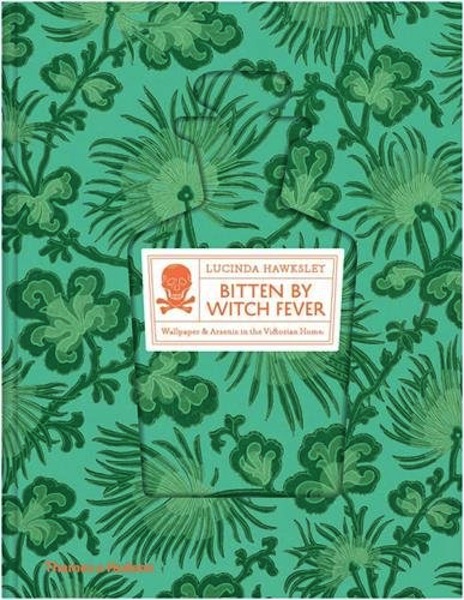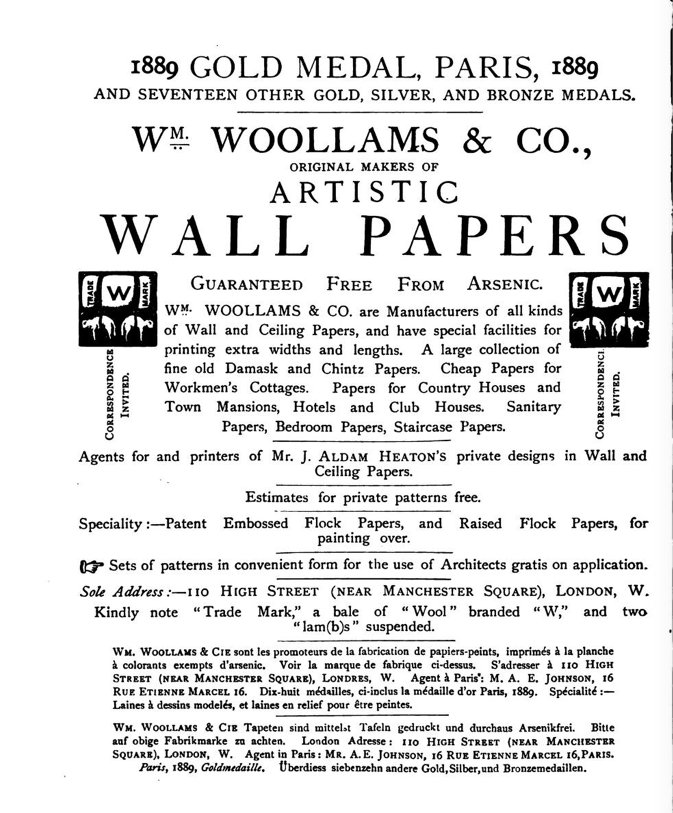This is a longer, illustrated version of a review that first appeared in the Times Literary Supplement of 9 February 2017. Apart from the photograph of the front cover at the beginning, the illustrations are from our own website. You may use them without prior permission for any scholarly or educational purpose as long as you (1) credit the source and (2) link your document to this URL in a web document or cite the Victorian Web in a print one. [Click on the images to enlarge them, and for more information about Morris's Merton Abbey works.]

Wallpaper production rose by an extraordinary 2,615 percent between 1834 and 1874, a period during which production had become mechanized and tax on it had halved and then been abolished altogether (see Hawksley 67). From the boldly architectural to the lushly floral, to birds trailing baubles on ribbons, there were patterns for every taste. Some would look overpowering now; others bring to mind ladies' powder-rooms in London clubs. On the page, however, they are simply dazzling. After all, they were by top designers like Christopher Dresser, and for top companies like Morris & Co. — and William Cooke of Leeds, whose flock wallpaper graced Prince Albert's bedroom at Balmoral. But beware. The virulent green of Lucinda Hawksley's cover has the shape of a vial impressed on it, and illustrates the link made in her subtitle. Every single one of the 275 patterns displayed in her book, and not just those that are predominantly green, was manufactured with pigment containing arsenic (see Hawksley 7).

The mill-pond at Morris's Merton Abbey Works, with the printing and weaving sheds.
On slimmer pages, quite lost among the samples, are Hawksley's introduction and seven short chapters of text. These are set in a fine typeface with ligatures, and conclude, not with footnotes, but keys in tiny print to the plates that follow. Yet this is more than a coffee-table book. The research has been substantial, covering everything from production processes to medical controversies, as well as developments on the Continent and America. The title comes from none other than William Morris himself, whose family had grown rich on its shares in the Devon Great Consuls, the Devonshire mine which was "one of the world's largest producers of arsenic," and of which Morris himself was one of its directors for four years from 1871 (Hawksley 59). For all his pioneering concern for his workers, he remained sceptical about the deleterious effects of arsenical colours: "the doctors were bitten as people were bitten by the witch fever," he believed (qtd. Hawksley p. 164), claiming as late as 1885 that wallpaper poisoning was a convenient explanation for any illness that resisted a more conventional diagnosis. It was a consultant physician by the name of Malcolm Morris (no relation), whose personal experience finally convinced him of the danger, writing in his Book of Health:
Arsenical wall-papers are another unsuspected cause of illness and depression, and their dangerous character is unknown to many, and is disbelieved in by many members of the medical profession. A year or two ago I myself belonged to this number. I received a circular urging united action to prevent the sale of arsenical wall-papers without the purchaser being informed that they contained arsenic. This I threw at once into the waste-paper basket, thinking that the danger alluded to in it was chimerical, inasmuch as I had prescribed arsenic medicinally to others with good results, and had also taken it myself without any injury — the quantities employed in both cases being, I thought, very much larger than were likely to come from a wall-paper. A month or two afterwards I learnt, by sad experience, how mistaken I had been. Having chosen an olive-green wall paper, I asked the vender whether it was free from arsenic or not; and being solemnly assured that it was, I had it put up. In a very short time indeed after it was hung, I began to suffer from dysenteric symptoms, with intense languor and weakness — symptoms which strongly indicate arsenical poisoning. Again I went to the shop where I had bought the paper, and repeated my question whether the paper was free from arsenic or not. "Oh yes, sir," was my reply; "there is no arsenic in any paper which we sell." The symptoms, however, were so clearly those of poisoning that I submitted a piece of the paper to a professional analyst, and he at once sent back the report, "The paper is loaded with arsenic." Although it was a good while before I recovered from the effects of this, I was much more fortunate than a medical friend, whose wife and himself were both nearly killed by the use of arsenical paint; or another medical man whose children died of symptoms which he was only led, after their death, to associate with the arsenic with which the nursery wall-paper was loaded. [212-13]
Malcolm Morris acted for an official enquiry into the subject initiated a few years later, which called for compulsory listing of dangerous substances to apprise consumers of the risks (see Cullen 107, 112), but Hawksley points out that "[r]emarkably, no legislation was passed in Britain,— in the nineteenth century or since — prohibiting the use of arsenic to colour wallpaper" (224).

Advert for non-arsenical wallpaper at the end of the century.
Meanwhile, from the late 1850s onwards, tragic cases like those mentioned above proliferated. Toxicity, at first imputed only to the green pigments, claimed the health and even the lives of unknown numbers of people. Perhaps the worst case was that of the Turner family in the East End's Limehouse. In 1862, when their fourth child died, aged three, a toxicologist was at last called in. But the discovery that the children had been tearing off and licking strips of green wallpaper was not enough to convince the jury, who passed a verdict of death from natural causes (see Hawksley 166-67). Only when evidence accumulated did market forces (in other words, popular demand) oblige the industry to produce and advertise arsenic-free wallpaper. Whatever he himself felt about it, Morris did, in fact, stop using arsenic in the production process in the 1870s, when he turned to the use of vegetable dyes, by which time he had also resigned from Devon Great Consuls (see Hawksley 134).
This is not a new topic. The William Morris connection, for example, was explored by William R. Cullen in Is Arsenic an Aphrodisiac? The Sociochemistry of an Element (2008). Disappointingly, the "References" section at the end of Bitten by Witch Fever only gives the sources of the illustrations; there is no bibliography.
Related Material
Bibliography
(Book under review) Hawksley, Lucinda. Bitten by Witch Fever: Wallpaper & Arsenic in the Victorian Home. Hardback. London: Thames & Hudson and the National Archives, 2016. 256 pp. £28.00 ISBN: 978 0 500 51838 0.
Cullen, William R. Is Arsenic and Aphrodisiac: The Sociochemistry of an Element. London: Royal Society of Chemistry, 2008.
Morris, Malcolm. The Book of Health. London: Cassell, 1884. Internet Archive. Contributed by University of California Libraries. Web. 20 March 2018.
Created 21 March 2018